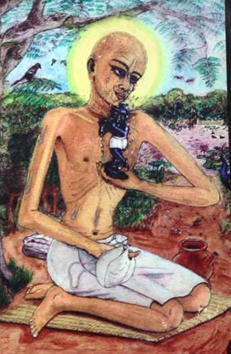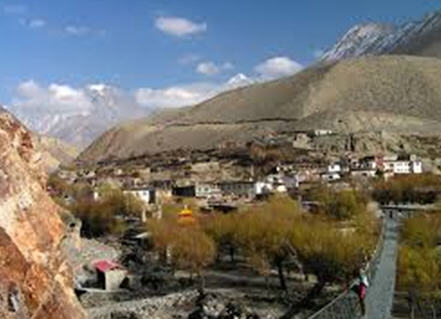

The famous temple of Lord Muktinath lies in the district of Mustang and is situated about 18 kilometers north east of Jomsom at an altitude of about 3,749 meters. The temple is situated on a high mountain range and is visited during fair weather. Situated at the base of the Thorong La mountain pass, Muktinath is a highly venerated sacred place for both Hindus and Buddhists.
Hindus call the site Mukti Kshetra, which literally means the “place of salvation” and it is one of the most ancient temples of the Lord Vishnu and the Vaishnava tradition in Nepal. The shrine is considered to be one of the eight sacred places known as Svayam Vyakta Ksetras (the other seven being Srirangam, Srimushnam, Tirupati, Naimisharanya, Totadri, Pushkar and Badrinath), as well as one of the 108 Divya Desam, or holy places of worship of Lord Vishnu. Additionally, it is also one of the 51 Shakti Pitha goddess sites.
The temple is small and contains a life-sized golden statue of Vishnu as Shri Mukti Narayana. In addition to Mukti Narayana, the temple has bronze deities of Bhoodevi (the Earth-goddess form of Lakshmi), the goddesses Saraswati and Janaki (Sita), Garuda (the mount of Vishnu), Lava-Kusa (the sons of Rama and Sita) and the Sapta Rishis (Seven Sages created by Lord Brahma). There is an old Buddhist monk present in the temple and worship is conducted by Buddhist nuns.

Behind the temple is a semi-circular wall with 108 stone faucets at a height of seven feet. All the faucets have the same shape of the head of a bull and are separated by approximately one foot. Water from the ice-cold Kali Gandaki river has been diverted to flow through the mouths of these bulls and hardy pilgrims who visit the temple often stand beneath each of the spouts.
The Kali Gandaki riverbed downstream from Muktinath is the source of the rare Shaligram stones. The Holy stones are available all the way from Damodar Kunda to Gajendramoksha Divyadham.
All four species: Jarayuj (root breed), Swoidesh (self breed), Andaj (egg breed), and Udima (birth breed) who visit the place and worship gods get salvation after their death.
Besides Lord Vishnu, Brahma and me with other gods and sages shall be with you, says Lord Shiva while pronouncing the sacred value of the place. To have a holy dip at Krishna gandaki is equal to hundred holy dips at other pilgrimage sites in terms of the salvation.
]
Buddhists call Muktinath as Chumig Gyatsa, which in Tibetan means ‘Hundred Waters’. According to Tibetan Buddhism Chumig Gyatsa is a sacred place of the Dakinis goddesses known as sky dancers, and also one of the twenty four celebrated tantric places. Additionally, the site is believed to be a manifestation of Avalokitesvara, the Bodhisattva of compassion and virtue. The Tibetan Buddhist tradition states that Guru Rimpoche, also known as Padmasambhava, the founder of Tibetan Buddhism, meditated here on his way to Tibet.
After completing prayers and worship at the Muktinath temple, many pilgrims both Hindu and Buddhist, visit Mebar Lha Gomba, the small monastery of `miraculous fire’, which is situated near the entrance gate of the temple. This monastery, dedicated to Guru Rimpoche (Padmasambhava) and containing a statue of the Buddhist deity Chenrezig (Avalokitesvara), is famous for its continuously burning natural gas fire, which Hindus worship as Jwala Mai, the Goddess of Fire.
Damodar kunda

Damodari Ganga springs along Shaligram Parvat which contains Shaligram (sanctifying sacred stones)
It is the holy part of Damodar Himal elevated to 22,000 feet high from sea level situated in Mustang district.
There are numerous sanctifying glacial lakes, both small and large, where Damodari Ganga takes her form, Damodar kunda being the largest one. As a confluence of lakes and ponds such as Brahmakunda, Rudrakunda and Anantakunda; Damodarkunda contains the largest volume of water. Damodarkunda, the estuary of Krishnagandaki river, is one of the holiest pilgrimage sites for Hindus. Several colophons of religious scriptures describe the heavenly bliss of this Kunda (sacred pond).So, it bears both religious and historical importance. A unique place to feel ecstasy of self and be transported to holy bliss. Damodarkunda is one of the holiest of terrestrial shrines, so it is reverently described in Puranas, the holy books of Hinduism. Among six Goswamis, Srila Gopal Bhatt Goswami visited this place and it was here while bathing that few shalagram shilas jumped into his hands which he carried it with him as Lord’s desire to Vrindavan dham, where they are still worshipped today in the temple and one of which miraculously transformed as Shri Shri Radha Ramanji.

Shaligram


Gloriously described in Puranas as Krishnagandaki (Black Gandaki) as well as Chakranadi, and worshipped as one of the holiest rivers, Krishnagandaki consists of seven Gandaki rivers supposed to have sprung from cheek (Gandasthal) of Lord Vishnu. It has a distinct honor of being the only river in the world to contain sacred stones (Shaligrams). Shaligram forms the stone incarnation of Lord Vishnu. Devout worship these stones at their homes with utmost reverence and devotion.
Krishna gandaki, inexhaustible reservoir of Shaligram starts from Damodar Himalaya and flows southward through Mukti Kshetra (the place of salvation).According to the Varaha Purana, the place is named after a sage Gandaki, who sat in a penance here. The Krishna Gandaki river is said to have sprung as perspiration from the cheek (Gandak) of the Lord Vishnu and hence the name Gandaki.
Kaagabeni

According to the Puranas, this place been named after the famous crow bodied sage called Kaga bhusundi who sat in penance at this place. Kaagaveni lies at the bank of Kali Gandaki River on the way to Muktinath few miles away from Jomsom. This is renowned as a confluence of two rivers: Krishna Gandaki and Kaga Khola . One who performs Pitree Shradda (a rite performed to commemorate the death of the elders’ esp. parents) near Kagaveni can easily facilitate the dead towards redemption. The value of Shradda at this place is many times more prominent than that at Gaya.
Pokhara Valley :
The Pokhara Valley – one of the most picturesque spots of Nepal, is enhanced by its lovely lakes Phewa, Begnas, and Rupa. Situated 200 kilometers west of Kathmandu, Pokhara is connected by air as well or by bus from Kathmandu and Bhairahawa a border town near India. Situated at an altitude of 827 meters from the sea-level, Pokhara offers the magnificent views of Dhaulagiri, Manaslu, Machhapuchhre, five peaks of Annapurna and others.
“]























